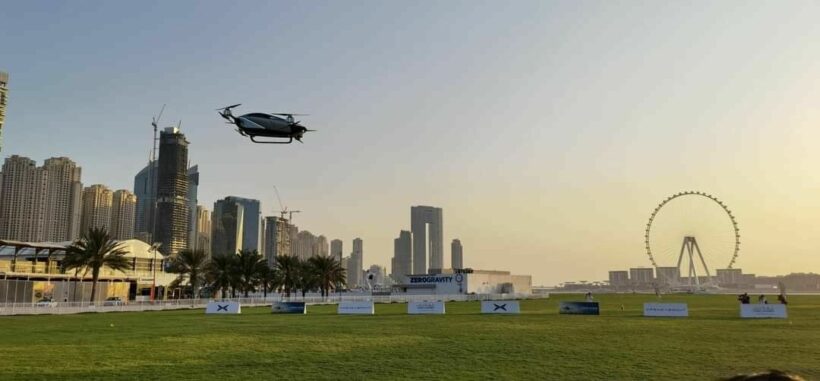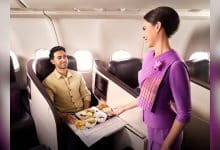Flying taxis ready for takeoff inside three years

Flying taxis are the future, and not just a science fiction fantasy, right?
Imagine, it’s raining, the road is gridlocked and you’re going nowhere fast trying to flag down a taxi outside of Terminal 21, EmQuartier or Central World. The taxi drivers that do stop won’t turn on their meters and are charging 300 baht to take you to Phrom Phong. You think, I might pay 300 baht for a flying taxi but not for a ride in a stinky cab. If only there were flying taxis to get me out of this hell hole. Hey! Flying taxis! There’s an idea!
Many developers in the United States believe so too. Not only that, they believe they will have the safety of their vehicles certified and cleared for takeoff by 2025, if not sooner. Boeing, Airbus and Hyundai are some of the names building air taxis. Another is Joby, which bought Uber Elevate, the ride-sharing giant’s foray into eVTOLs, in December 2020. And only yesterday, German startup Volocopter raised an additional US$182m to commercialise its electric air taxi.
Flying taxis make sense, they’ll take the weight off busy roads and can transport passengers much faster than public transport to places such as airports and busy city centres. There will be problems to overcome, such as heliports and integrating them into existing air-traffic-control systems but that can’t be such a big problem. Heliports or vertiports can be mapped out on the buildings of popular shopping malls and even car parks
Wisk Aero CEO Gary Gysin reckons flying taxis will be here sooner than you think.
The California, US-based company, backed by aerospace giant Boeing Co., is developing a flying taxi that would seat four passengers but with no pilot, reported Bangkok Post.
Gysin said…
“Are these flying taxis for real? Yes, they are for real.
“To me, it’s like the early auto industry. It’s just not possible there are going to be 200 companies that actually survive and build a full-scale aeroplane that gets certified for flight in the US or flight in Europe.
“There are many serious, credible players, and this market will absolutely happen. Maybe 2025 is the first time you might see a piloted version of an air taxi that enters the market. But it’s 2025 to the end of the decade when you’ll start to see all the action.
“Flying taxis are dramatically quieter than a helicopter. If you spin the blade slower, it’s quieter. And so, everybody is working on their technologies to make sure the rotors and the blades are big enough so you can spin them slower, still get the lift and propulsion you need and be super quiet.
“The loudest part is when you take off and land. The quietest is when you’re flying like an aeroplane.”
This is what a trip in a flying taxi might be like. pic.twitter.com/o8ipgYN93W
— CNET (@CNET) November 6, 2022
Now that the flying seed has been planted and continues to grow, what about problems such as persuading the public to fly in them, given they will be pilotless?
“This form of flying will be safer than any form of aviation that exists today. But that’s easy to say. What we need to do is prove it with data.
“There’s the screen that’s in each seat — it shows your flight route, when you’re going to the bank, how much time you have left in the flight, etc. At any point in time, you can hit a button and talk to somebody on the ground. For whatever reason, to your point, to get that comfort. There’s also a help button inside the cabin if you want, and again, someone will come on immediately.
“We still have humans in the loop, we still have pilots — they’re on the ground. And they are the ones that will be in touch with air-traffic control, they’re the ones that will be in touch with the passengers that are on board.
“We are flying prescribed routes, but if for some reason, a pilot needs to intervene, they can.”
Flying taxis would be more expensive though, right? No! Gysin insists the prices will remain the same but just faster.

“Yes, orders of magnitude faster.”
But how will that be financially viable? Won’t the business crash and burn?
“We think it’s the only way the market really scales. Think about it, no pilot, we don’t have the normal pilot-training costs in the cockpit. It’s all electric, so there are fewer parts, and fewer things to service. So, the operating cost for this is pretty low.”
Gysin insists that setting up heliports, or vertiports wouldn’t cause too much fuss, and adding buildings wouldn’t need to have reinforced roofs because flying taxis are lighter than helicopters.
“You have to have communications infrastructure to be able to talk to the aircraft. And then where are you going to land? The good news is we don’t need an airport. We don’t need a runway. You need a pad.
“So, what do you need there? You need electric charging infrastructure for all-electric aircraft. And then you’ll need sensors that are outfitted around a vertiport for autonomous landing.
“Our idea is to leverage existing general-aviation airports and existing helipads. You’ll see a lot of videos where there’s a shiny new vertiport on top of the building. And that’s great. But there are also helipads that are unused that are on top of buildings already, and those certainly can be outfitted.”
That’s sorted! Goodbye to those scamming taxi drivers on Sukhumvit Road, hello to flying taxis, as long as they use a meter, that is.
Latest Thailand News
Follow The Thaiger on Google News:


























